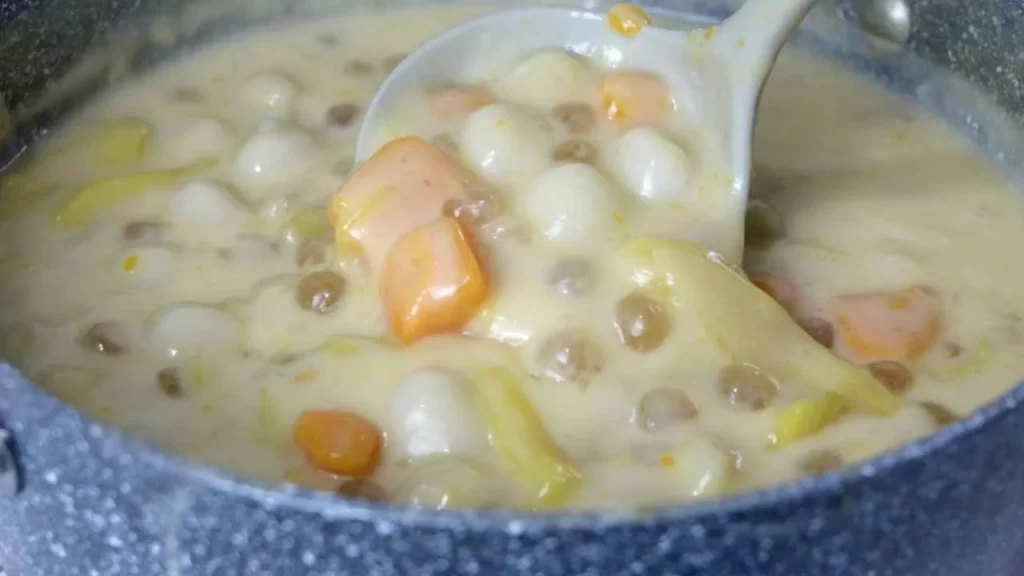Binignit is a delicious dessert from the Visayan region in the Philippines, often served hot or cold. It’s a filling meal during Holy Week, particularly on Good Friday when Catholics avoid meat. This dessert is like a tropical fruit and tubers stew cooked in coconut milk. It’s similar to Ginataang Halo-halo but without glutinous rice balls.
Instead, it uses Muscovado sugar and tapioca pearls or (landang) for a unique taste and texture. Preparing binignit is simple, but it’s best to have all the ingredients ready. Tapioca pearls should be boiled and soaked beforehand. The dish offers a perfect balance of sweetness and distinct flavours from various ingredients like sweet potatoes, taro, purple yam, jackfruit, and saba bananas. It’s a delightful Filipino dessert enjoyed during special occasions.
The Story Behind This Recipe
Binignit, a cherished Filipino dessert, has its roots in the Visayan region, a cluster of islands in the heart of the Philippines. This delightful dessert holds cultural significance as it is predominantly savoured during Lent and Holy Week, perfectly suiting the Catholic tradition of abstaining from meat during this sacred period. However, its appeal extends far beyond religious observances and is often a star at fiestas and intimate family gatherings.
What makes binignit so special is its emphasis on local ingredients, which beautifully mirrors the Philippines’ bountiful agricultural resources. The traditional recipe harmoniously combines various elements of the region’s rich produce. It boasts a delightful medley of flavours and textures, with sweet potatoes, taro, purple yam, jackfruit, and bananas forming the foundation. These ingredients not only lend a hearty and starchy base but also contribute to the dessert’s natural sweetness.
The crowning glory of binignit is undoubtedly the creamy coconut milk, an essential ingredient in Filipino cooking. This coconut milk infuses the dessert with its velvety richness, transforming it into a delectable indulgence.
The process of crafting binignit involves a simmering dance of these elements, allowing their flavours to intermingle and the root crops to reach a tender perfection. The end result is a comforting, flavourful dessert soup that has found a cherished place in the heart of Filipino cuisine. It embodies the spirit of a rich cultural heritage intertwined with the abundance of local produce, making it a beloved and satisfying treat for Filipinos across the country.

Ingredients
- 1 cup water
- 1 cup sticky rice (malagkit rice), washed and drained
- 1 cup diced taro (gabi)
- 4 cups coconut milk
- 1 cup diced sweet potatoes (kamote)
- 1 cup sugar
- 1 cup diced purple yam (ube)
- 1 tablespoon vanilla extract
- 1 cup diced ripe jackfruit (langka)
- 1 cup sliced saba bananas
- 1/4 teaspoon salt
- Optional toppings: toasted coconut flakes or fried saba bananas
Step by step instructions for making binignit
- In a big pot, put together the coconut milk, water, sticky rice, sweet potatoes, taro, and purple yam. Heat it on medium until it starts to boil. Remember to stir now and then to prevent sticking.
- Turn the heat down to low and let it simmer for around 15 minutes or until the root crops become soft.
- Add the jackfruit and saba bananas into the pot and keep cooking for another 5 minutes.
- Put in the sugar, salt, and vanilla extract. If you want it sweeter, add more sugar as per your liking.
- Keep cooking for another 5 minutes, giving it a good stir from time to time to blend the flavours.
- Once everything is tender and the flavours have come together, take the pot off the heat.
- Serve binignit while it’s warm in bowls. You can also sprinkle some toasted coconut flakes or add fried saba bananas on top for extra crunch and flavour.
Tips for making better binignit
- Make sure to cut all the ingredients into similar sizes so they cook evenly.
- When you’re simmering the coconut sauce, be gentle and don’t let it come to a boil. This will help prevent it from curdling or separating.
- If you’re using ready-to-eat sago in the US, it usually comes in thick syrup. Make sure to drain it well, or your dessert might end up too sweet.
- f you don’t have regular brown sugar, you can use muscovado sugar to sweeten it.
- If you prefer a stickier Binignit, you can add ground rice flour or ground glutinous rice. Put this in the pot before adding other ingredients, and adjust the water quantity since rice flour and glutinous rice absorb water as they cook.
- Cut the taro, ube, and sweet potatoes into cubes. It not only looks nice in the dessert but also speeds up the cooking time.
- If you’re using whole glutinous rice, soak it in water for 30 minutes to 1 hour before adding it to the Binignit to reduce the cooking time.
Serving suggestions
- Traditional Bowl: Serve Binignit in individual bowls, allowing everyone to savour their portion of this delightful dessert soup.
- Garnish with Latik: Top each serving with a sprinkle of latik, a traditional Filipino topping made from coconut milk solids. It adds a rich, caramelized flavour and a pleasing texture.
- Add a Dollop of Leche Flan: For an extra special touch, place a small piece of leche flan (caramel custard) on top of each serving. The creamy sweetness of leche flan pairs beautifully with Binignit.
- Serve with Rice Cakes: Accompany your Binignit with traditional Filipino rice cakes like bibingka or puto. These soft, sweet treats complement the flavors of Binignit.
- Pair with Hot Tsokolate: Enjoy a cup of Filipino tsokolate (hot chocolate) alongside your Binignit. The warm, comforting cocoa flavour contrasts with the dessert’s sweetness.
- Include Saba Banana Fritters: Serve saba banana fritters on the side. These fried or grilled bananas provide a delightful banana flavor that complements Binignit.
- Decorate with Edible Flowers: For an elegant presentation, add a few edible flowers as a garnish. This adds colour and a touch of sophistication to your dessert.
- Chilled or Warm: Binignit can be served either chilled or warm, depending on your preference. Some enjoy it warm, while others prefer it cold.
- Family Style: Serve Binignit in a large bowl for a family-style dessert. Let everyone scoop out their desired portion.
- Pair with Filipino Sweets: Combine Binignit with other Filipino sweets and pastries like cassava cake or maja blanca for a dessert feast.








